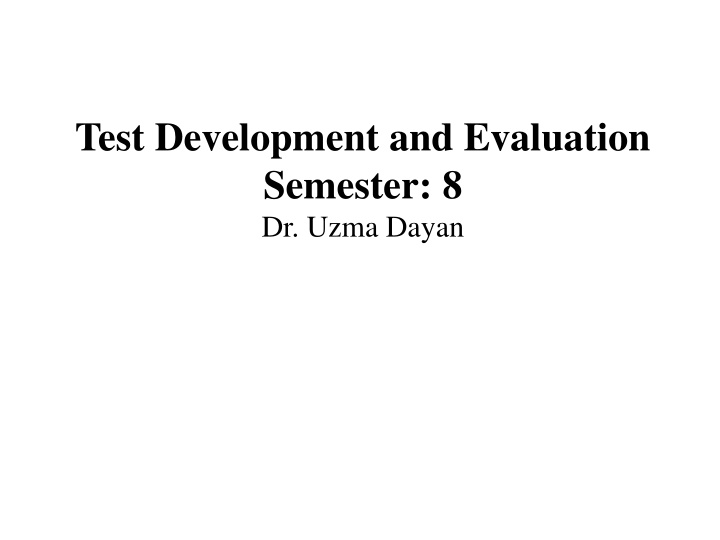
Criterion-Referenced and Norm-Referenced Tests
Learn the differences between Criterion-Referenced Tests (CRT) and Norm-Referenced Tests (NRT), their uses in schools, and why Criterion-Referenced Tests are important for assessing student knowledge and skills.
Download Presentation

Please find below an Image/Link to download the presentation.
The content on the website is provided AS IS for your information and personal use only. It may not be sold, licensed, or shared on other websites without obtaining consent from the author. If you encounter any issues during the download, it is possible that the publisher has removed the file from their server.
You are allowed to download the files provided on this website for personal or commercial use, subject to the condition that they are used lawfully. All files are the property of their respective owners.
The content on the website is provided AS IS for your information and personal use only. It may not be sold, licensed, or shared on other websites without obtaining consent from the author.
E N D
Presentation Transcript
Test Development and Evaluation Semester: 8 Dr. Uzma Dayan
Topic: Criterion-referenced and Norm- referenced tests
Lesson objectives By the end of the lesson, students will be able to: Differentiate between Criterion-referenced tests (CRT) and Norm- referenced tests (NRT). State uses of CRT and NRT. Describe ways of interpreting CRT and NRT.
Criterionreferenced test (CRT) A criterion-referenced test is designed to measure a student's academic performance against some standard or criteria. This standard or criteria is predetermined before students begin the test. Schools or districts choose a standard, such as a percent of items answered correctly or a state test benchmark, as the criteria for the test. The student's score then shows the progress they have made toward the agreed-upon standard-
Example 1 When you take your temperature, the accepted healthy standard is 98.6 degrees Fahrenheit. If your temperature is higher, you are not meeting the standard for health and are likely ill.
Example 2 GRE Score required: 50 A candidate scores 49 which might be the highest among all candidate. Still the candidate is not attaining the criterion.
Uses What are these tests used for in schools? Schools use criterion-referenced tests to assess the specific knowledge and skills students have most likely learned in order to assess how close a student is to mastering a specific standard. We say most likely because there is no absolutely perfect way to measure things we cannot directly see without some error.
Importance Why are criterion-referenced tests important? We want to know what students have already learned and what we can do to help them achieve proficiency or meet the desired learning standard. For example, performance on state assessments is often of critical importance for districts. Criterion-referenced tests will show you where students are in relation to state test benchmarks (or other agreed-upon standards) at any given time, letting you structure instruction and intervention for students who need it.
Norm-referenced test (NRT) Norm-referenced refers to standardized tests that are designed to compare and rank test takers in relation to one another. Norm- referenced tests report whether test takers performed better or worse than a hypothetical average student, which is determined by comparing scores against the performance results of a statistically selected group of test takers, typically of the same age or grade level, who have already taken the exam.
continue Norm could be a student, a class, a school or a district. For example, a student with the highest score in a test becomes norm for the rest of the class because the score of other students are compared with his/her score.
continue Calculating norm-referenced scores is called the norming process, and the comparison group is known as the norming group. Norming groups typically comprise only a small subset of previous test takers, not all or even most previous test takers. Test developers use a variety of statistical methods to select norming groups, interpret raw scores, and determine performance levels.
continue Norm-referenced tests often use a multiple-choice format, though some include open-ended, short- answer questions. They are usually based on some form of national standards, not locally determined standards or curricula. IQ tests are among the most well-known norm-referenced tests, as are developmental-screening tests, which are used to identify learning disabilities in young children or determine eligibility for special-education services.
Purpose N.R.T s are used for grouping purpose.
Example SAT (Scholastic Aptitude Test); IQ tests; and tests that are graded on a curve. Anytime a test offers a percentile rank, it is a norm- referenced test.
continue The following are a few representative examples of how norm-referenced tests and scores may be used: 1. To determine a young child s readiness for preschool or kindergarten. These tests may be designed to measure oral-language ability, visual-motor skills, and cognitive and social development.
continue 2. To evaluate basic reading, writing, and math skills. Test results may be used for a wide variety of purposes, such as measuring academic progress, making course assignments, determining readiness for grade promotion, or identifying the need for additional academic support. 3. To identify specific learning disabilities, such as autism, dyslexia, or nonverbal learning disability, or to determine eligibility for special-education services.
continue To make program-eligibility or college- admissions decisions (in these cases, norm- referenced scores are generally evaluated alongside other information about a student). Scores on SAT or ACT exams are a common example.
Growth-referenced test: In growth reference tests the learning growth of students is being observed. It is done through Pre- test, post-test. For example, a test is administered in the beginning of a program to see the position of students (pre-test), then at the completion of the program (post-test) to see the progress of students. Growth- reference test is a mechanical process for the teachers. Chances of error are there such as illness of students, weather condition, country scenario etc.
Exit Ticket Task for students: 1. Give 2 examples of CRT and NRT from local context. 2. Write (in one sentence) the difference between CRT and NRT.




















